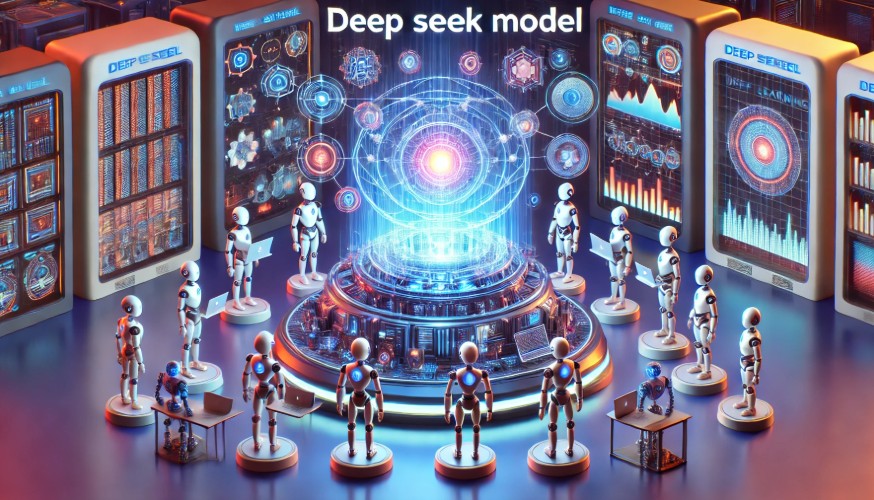Table of Contents
- 1 Introduction
- 2 What is the Deep Seek Model?
- 3 How the Deep Seek Model Works
- 4 Applications of the Deep Seek Model
- 5 Examples of the Deep Seek Model in Action
- 6 Frequently Asked Questions (FAQ)
- 6.1 1. How does the Deep Seek Model differ from traditional AI models?
- 6.2 2. Can the Deep Seek Model be used in small businesses?
- 6.3 3. What industries benefit the most from Deep Seek?
- 6.4 4. How can I implement the Deep Seek Model in my organization?
- 6.5 5. What are the challenges of using Deep Seek?
- 7 External Resources
- 8 Conclusion
Introduction
Artificial intelligence has revolutionized various industries, and the Deep Seek Model is among the most powerful AI-driven approaches available today. It enhances data retrieval, decision-making, and automation processes by leveraging deep learning principles. This guide explores how the Deep Seek Model works, its applications, benefits, and real-world examples.
What is the Deep Seek Model?
The Deep Seek Model is an advanced AI framework that utilizes deep learning techniques to analyze, retrieve, and process information efficiently. It is designed for tasks such as:
- Natural Language Processing (NLP)
- Predictive Analytics
- Image and Speech Recognition
- Data-driven Decision Making
- Search Optimization
The model is particularly useful for enterprises that require sophisticated AI capabilities to improve efficiency and accuracy.
How the Deep Seek Model Works
1. Data Collection and Preprocessing
The Deep Seek Model starts by gathering data from multiple sources. The preprocessing phase includes:
- Data Cleaning: Removing noise and irrelevant information.
- Normalization: Standardizing data formats.
- Tokenization: Splitting text into manageable units.
- Feature Engineering: Extracting meaningful features for better predictions.
2. Deep Learning Architecture
The model employs neural networks, particularly:
- Convolutional Neural Networks (CNNs): Ideal for image and pattern recognition.
- Recurrent Neural Networks (RNNs): Suitable for sequential data processing.
- Transformer Models: Used in NLP for improved context understanding.
3. Training and Optimization
Deep Seek leverages backpropagation and gradient descent to refine model accuracy. It utilizes large datasets to improve:
- Generalization: Ensuring the model performs well on unseen data.
- Scalability: Adapting to different industries and applications.
- Efficiency: Reducing computation time while maintaining accuracy.
4. Deployment and Real-Time Processing
Once trained, the Deep Seek Model can be deployed for real-time applications such as:
- Chatbots and Virtual Assistants
- Predictive Maintenance Systems
- Fraud Detection Mechanisms
Applications of the Deep Seek Model
1. Healthcare
- Disease diagnosis based on medical images.
- Personalized treatment plans using AI predictions.
- Drug discovery acceleration through data analysis.
2. Finance
- Risk assessment for loan approvals.
- Fraud detection in transactions.
- Algorithmic trading for stock market insights.
3. E-commerce
- Personalized product recommendations.
- Customer sentiment analysis.
- Chatbots for enhanced user experience.
4. Marketing and Advertising
- Targeted ad placement.
- Social media trend analysis.
- Automated content generation.
5. Autonomous Systems
- Self-driving cars utilizing AI navigation.
- Smart home automation for energy efficiency.
- Robotics applications in manufacturing.
Examples of the Deep Seek Model in Action
Basic Example: Sentiment Analysis
A company wants to analyze customer feedback. The Deep Seek Model processes thousands of reviews and categorizes them as positive, neutral, or negative.
Intermediate Example: Fraud Detection
A financial institution employs Deep Seek to analyze transactional patterns. The model flags suspicious transactions in real-time, reducing fraud risks.
Advanced Example: Self-Driving Cars
An automotive company integrates Deep Seek into its AI system. The model helps recognize obstacles, predict movements, and optimize navigation paths.
Frequently Asked Questions (FAQ)
1. How does the Deep Seek Model differ from traditional AI models?
Unlike traditional models, Deep Seek leverages deep learning architectures that enable self-improvement over time, enhancing accuracy and adaptability.
2. Can the Deep Seek Model be used in small businesses?
Yes, it can be scaled for small and medium enterprises (SMEs) to improve customer service, automate processes, and optimize decision-making.
3. What industries benefit the most from Deep Seek?
Industries like healthcare, finance, e-commerce, and transportation see significant improvements through its implementation.
4. How can I implement the Deep Seek Model in my organization?
You can start by integrating AI-based analytics tools or working with AI service providers who specialize in deep learning models.
5. What are the challenges of using Deep Seek?
- High computational costs
- Need for large datasets
- Interpretability of AI decisions

External Resources
For further reading, check out these authoritative sources:
Conclusion
The Deep Seek Model is a powerful AI-driven framework capable of transforming various industries through enhanced data analysis, automation, and predictive capabilities. Businesses and researchers can leverage this model to improve efficiency, accuracy, and decision-making. As AI continues to evolve, the potential applications of Deep Seek will expand, making it an essential tool for the future of technology. Thank you for reading the DevopsRoles page!
